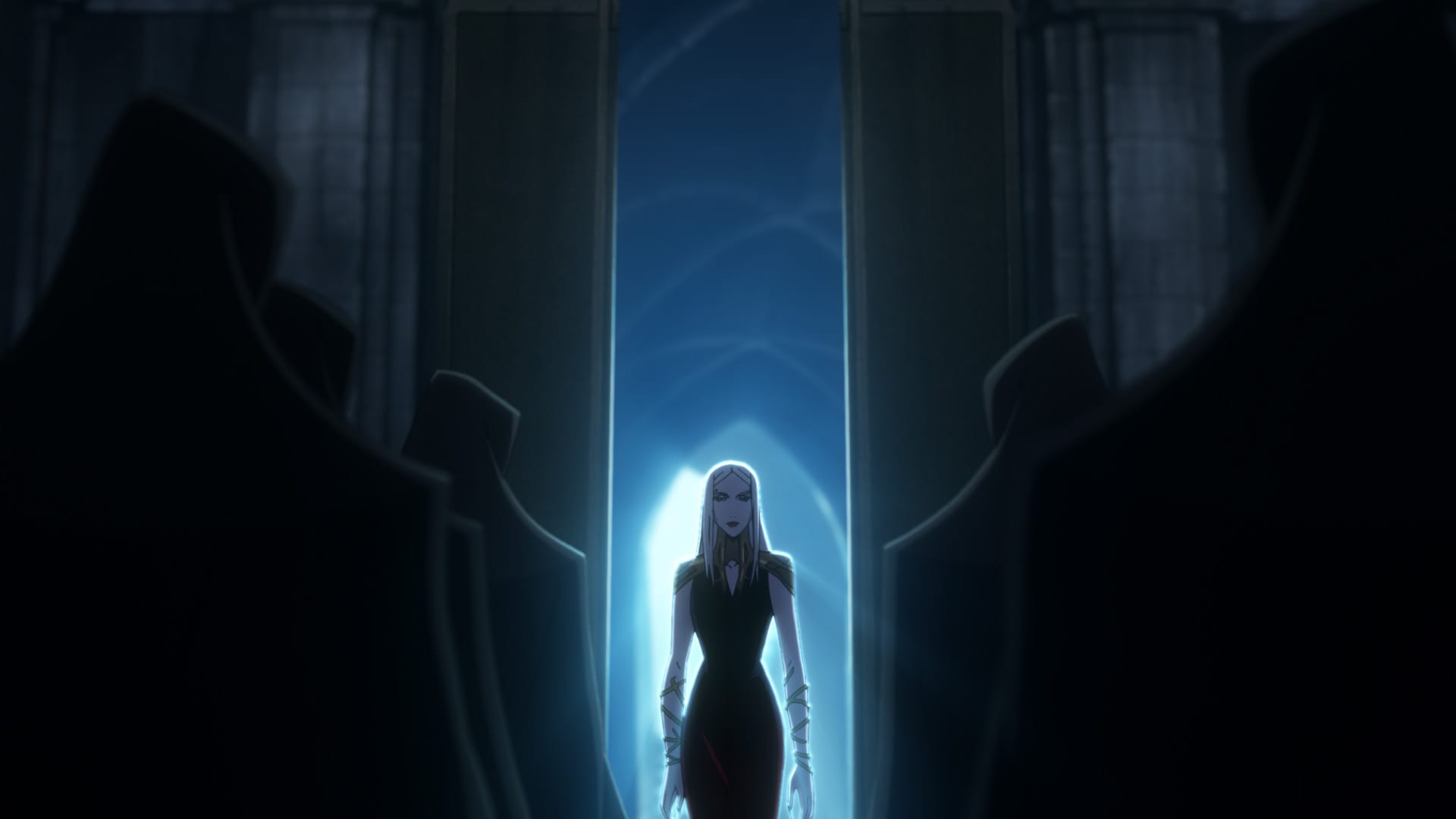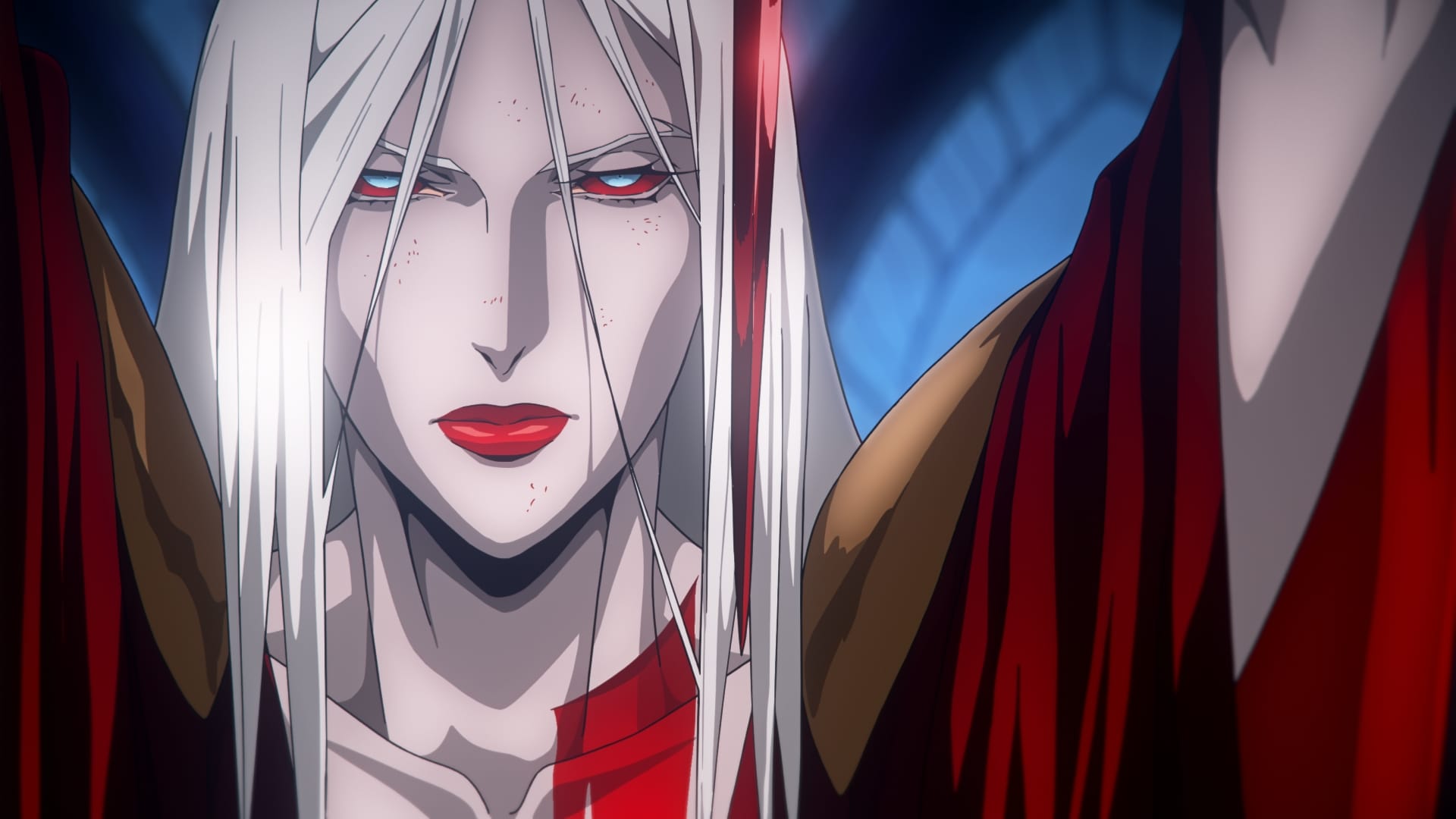For centuries, vampires have checked a lot of existential (and down bad) boxes as a perfect foil for our darkest cravings and existential dread. From Park Chan-Wook’s Thirst, Tomas Alfredson’s Let the Right One In, Neil Jordan’s Byzantium, and Ryan Coogler’s Sinners, I’ve enjoyed contemporary vampiric teas, imbibing the malignant and intoxicatingly self-destructive codependency monsters that make the horror myth so alluring. Yet, like the monster, I craved more.
On impulse, I recently followed that gothic rainbow of vampiric yearning back to its origin. Not Dracula. Not Nosferatu. But Carmilla–more specifically, writer Carmen Maria Machado’s version of the 1872 Gothic novella by writer Joseph Sheridan Le Fanu. Having emerged from an afternoon reading the novel from cover to cover, I realized that every iteration inspired by it, like Powerhouse Animation’s Castlevania Netflix series, were just watered-down versions, a realization inspired by Machado’s version rage-baiting me into queer enlightenment.
!!!!!!!! pic.twitter.com/YHgotQvp4K
— 𝑳𝑰𝑽𝑰𝑵𝑮 𝑫𝑬𝑨𝑫 𝑮𝑰𝑹𝑳 🦇 (@screamnhorror) November 14, 2025
As Amelia Brown wrote in her Ploughshares essay, Machado’s version of Carmilla is unquestionably “both playfully reclaiming a story that was never stolen while also reclaiming a history that definitely was; the literary history of queer desire.” In the introduction to Carmilla, Machado mentions a real-life event first noted by scholar Professor Leight, who posited that Laura and Carmilla were based on an affair between two women, Marcia Marén and Veronika, one which Electric Literature curiously notes no version of Carmilla had ever mentioned before Machado’s. The implication is that Le Fanu took the queerness (and low-key plagiarism) of a correspondence between one Dr. Hesselius and his patient, Veronika Hausle, and turned it into the foundational vampiric novella. In doing so, he excised parts that would’ve made the whole “Is Carmilla queer text” of it all crushingly obvious.
But Machado’s introduction is also a lie. She made up Leight, Marcia, and Veronika; Dr. Hesselius is cited in Le Fanu’s prologue, and is presumably a fiction, but without any of the queer context Machado adds. Or better put, Machado’s introduction is a flex of “manuscript fiction” as folks on the r/books subreddit I quickly flocked to put it. Machado, for my estimation, was using the same benefit of the doubt introduction Le Fanu used in his equally dubious 19th-century prologue, to (perhaps too cutely) reclaim Carmilla as an inalienable queer tale with vague gestures at made-up figures to give credence to that fact.
Put simply, I was reading a version of the book at war with itself, and one where I arrived at my own truth about the intent, and lack thereof, of its original author and the state of queer texts being a collective hallucination of starved readers or some slight of hand by the author to obscure its original meaning. It’s the embodiment of “I love spreading misinformation on the internet” housed in the perceived sanctity and empirical truth of a book. Still, like a vampire’s familiar putting up with hickies on their neck, I gave in to the lucid, Mandela effect reading experience that Machado’s Carmilla was inviting me into and found the pieces I walked away with to be beautiful enough to be my own truth about the work.

Carmilla is delightfully riotous. A slow-burning mystery, it follows Laura, a rich girl who, after insisting that her wealthy father let a mysterious girl named Carmilla stay at their secluded mansion, experiences a strange sickness as she, her father, and housemaids piece together that her unbearably pretty roommate has been treating her like a Capri-Sun pack for weeks. Machado’s edits exist as footnotes gingerly spread throughout the book, and despite the deception of the introduction, don’t rearrange words for modern audiences.
My favorite (and very loud) “excisings” among Le Fanu’s omissions of Veronika’s correspondence to her doctor that Machado places in her introduction is a letter where Veronika writes, in no uncertain terms, that the Victorian gals consummated their affair: “I descended the valley of her, over and over, until neither of us could locate our breath.” Contrast that with Le Fanu’s portrayal of Laura and Carmilla’s relationship, where Laura registers Carmilla’s toxic affections as merely sinister—never as the site of a conflicted, inchoate sexual awakening. Machado treats this tension not as subtext but as text, both inventing and excavating the erotic charge buried beneath Le Fanu’s pearl-clutching editorializations of Veronika’s letters to Le Fanu’s doctor. Letters, mind you, that Le Fanu dared to preface in his 1871 prologue by noting that the author of these letters (in this edit, Veronika) was already dead—and thus, in his words, “she probably could have added little to the narrative which she communicates, with such fastidious detail, in the following pages”—before proceeding, in Machado’s casting, to redact her correspondence with a smug confidence that omits all the most revealing parts.
Machado’s fabricated reasoning not to include excised text from Veronika’s letters into Carmilla as told from Laura’s perspective (which, again, don’t exist), while admittedly “petty,” felt to me like reading one of those “this you” quote retweets while also dunking on the original poster:
“I wished this edition to bear LeFanu’s shame. I wish the reader to come to the book with a complete understanding of its inadequacy…I hope you will enter into Carmilla thusly, using your fingertips and mouth and mind to locate the lacunae where Le Fanu excised pieces of Veronika’s account, the hallways haunted by the specters of truth and phantoms of passion. See if you cannot perceive what exists below: the erotic relationship between two high-strung and lonely young women. The shared metropolis of their dreaming. An aborted picnic in the ruins.”
But, like a vampire's familiar, I decided to give in to the fantasy of Carmilla secretly being a glinted queer text that I was getting in on the ground floor of. And boy howdy was I picking up what Machado was putting down.
Machado’s Carmilla seeps with imaginary contempt and is cattily packaged. The footnotes explain the story like a friend candidly recounting drama from the night before. They provide shorthand annotations explaining what fancy words mean to the everyman while also removing the veil of elegance by spelling out things for what they are. Machado vividly enunciates the danger and desire coursing through Laura and Carmilla's roaring romance by reframing its gothic gestures as intimate, juvenile dramas. Carmilla's nightly visits become the secretive scurrying of a girl hiding under her friend's bed. Meanwhile, a passing mention of Cleopatra's tapestry transforms into a sly metaphor for erotic vulnerability. A breast bared not for pocket watch-flexing bling but for creatures to be drawn to the pulse beneath its bosom.

As a kept promise of Machado’s shrewd, lean addition to Le Fanu's Carmilla enduring as a shame in delighting in the Gothic yearning and sapphic doom of its text, Machado’s notes cut through the flowery language about rapid breathing and “a sobbing, that rose into a sense of strangulation, supervened, and turned into a dreadful convulsion” to write frankly, “If this isn't an orgasm, nothing is.” All of this, naturally, takes place on the sixty-ninth page of the 139-page novel. Sensational.
By the end of Machado’s Carmilla, I witnessed my perception of Carmilla transform from an empty vessel of plot proportion and danger to a Promethean flame that sets Laura ablaze, her blood running with the most tremendous excitement of her boring, rich girl life. I also was left gazing, hands folded behind my back, wondering if Veronika/Laura—the spitting image of the Our Lady of the Seven Sorrows by the climax of the novel—ever writhed in agony knowing her lovely creature would never cup her face in her hand, plant butterfly kisses on her cheeks and eyelids, or say her name again. Carmilla, Laura’s ferociously alive Wabi-sabi, overnight transitioned into a story she must tell to someone, anyone, to keep alive. In Machado’s telling, her real-life counterpart sought to sort it out by seeking counsel from Dr. Hesselius, before having her tale told by Le Fanu for profit and paraded in homages that didn’t know the original source to whom they were riffing.
The main trait of any vampiric tale is that of doomed yearning and excess. To that end, Machado invites readers to savor the curated meal she has prepared, even if it means transforming Le Fanu into a blithering idiot of a sous chef, where his every perceived sapphic omission acts as the excess fat that makes the marrow of Machado’s dish all the more savory. Whenever queerness rises to the surface of Le Fanu’s text, Machado nudges it into the open while practically looming over your shoulder to nod at your inquisitive glance at that line you just read being gay AF.
Machado’s Carmilla lets readers who want Carmilla to be a queer text to say that it is: a black rainbow of a formative horror novella. A four-car pile-up where megalomania, hubris, yearning, and infatuation crash. A book that's one-size-fits-all and sapphic as hell for all the languishers of the world to let out a heavy sigh of relief, feeling seen by a take on the vampiric tale that nudges queer subtext into the sunlight for all to see.


